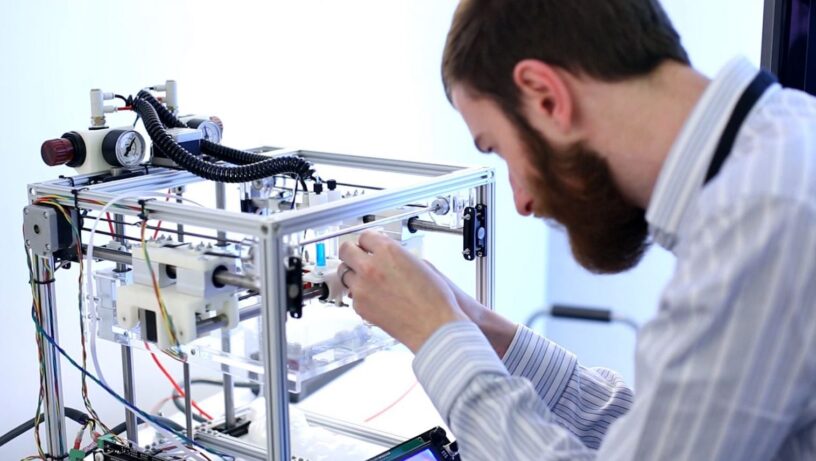3D Printing In Medical Applications Market Size in 2022 stood at USD 2.8 Billion and is set to reach USD 11 Billion by 2032, growing at a CAGR of 16.6%
The 3D printing in medical applications market involves the utilization of additive manufacturing technologies to create customized medical devices, implants, prosthetics, tissue scaffolds, and anatomical models for various healthcare applications. Here’s an overview of this market, including its scope, size, growth factors, key trends, and challenges:
Market Overview:
- 3D printing, also known as additive manufacturing, enables the creation of complex three-dimensional objects layer by layer from digital design files.
- In the medical field, 3D printing is used for a wide range of applications, including patient-specific implants, surgical guides, anatomical models for preoperative planning, drug delivery systems, and tissue engineering scaffolds.
- Key players in the market include medical device manufacturers, 3D printer manufacturers, material suppliers, and healthcare providers.
Market Size and Growth:
- The global 3D printing in medical applications market has been experiencing rapid growth due to factors such as advancements in 3D printing technology, increasing demand for personalized healthcare solutions, and rising prevalence of chronic diseases.
- Market size is influenced by factors such as healthcare expenditure, regulatory environment, technological innovation, and adoption rates of additive manufacturing in healthcare.
- According to recent market reports, the market is expected to continue growing at a significant rate over the forecast period, driven by expanding applications and the introduction of new materials and technologies.
Market Trends:
- Patient-Specific Implants: 3D printing enables the fabrication of patient-specific implants tailored to individual anatomical characteristics, improving fit, function, and patient outcomes in orthopedic and craniofacial surgeries.
- Surgical Planning and Training: Anatomical models created using 3D printing technology are increasingly used for surgical planning, simulation, and training, allowing surgeons to visualize complex procedures and practice before entering the operating room.
- Bioprinting and Tissue Engineering: The field of bioprinting involves the fabrication of living tissues and organs using bioinks composed of cells and biomaterials, holding promise for regenerative medicine, drug discovery, and personalized medicine.
- Dental Applications: 3D printing is widely used in dentistry for the fabrication of dental prosthetics, crowns, bridges, and orthodontic appliances, offering precision, customization, and rapid turnaround times.
- Point-of-Care Manufacturing: The adoption of point-of-care 3D printing in hospitals and clinics is increasing, allowing for on-demand production of medical devices and implants, reducing lead times and costs associated with traditional manufacturing methods.
Challenges:
- Regulatory Hurdles: Regulatory requirements for medical devices and implants manufactured using 3D printing technologies can be complex and vary by region, posing challenges for market entry and product approval.
- Material Selection: The availability of biocompatible and regulatory-compliant materials suitable for 3D printing in medical applications is limited, hindering the development of certain devices and implants.
- Quality Control: Ensuring the quality, safety, and consistency of 3D-printed medical devices and implants requires robust quality control measures and validation processes, which may be challenging for some manufacturers.
- Scalability: Scalability of 3D printing processes for mass production of medical devices and implants at a competitive cost remains a challenge, particularly for complex or large-scale applications.
- Cost and Reimbursement: The initial investment in 3D printing equipment and materials, as well as uncertainty around reimbursement for 3D-printed medical devices and implants, can be barriers to adoption for healthcare providers and patients
Click Here, To Get Free Sample Report https://stringentdatalytics.com/sample-request/3d-printing-in-medical-applications-market/15623/
Market Segmentations:
Global 3D Printing in Medical Applications Market: By Company
3D Systems
Eos GmbH Electro Optical Systems
Nanoscribe
EnvisionTEC
Stratasys
Global 3D Printing in Medical Applications Market: By Type
Polymers
Ceramics
Metals
Biological Cells
Global 3D Printing in Medical Applications Market: By Application
Medical Implants
Bioengineering Products
Surgical Instruments
Others
Global 3D Printing in Medical Applications Market: Regional Analysis
The regional analysis of the global 3D Printing in Medical Applications market provides insights into the market’s performance across different regions of the world. The analysis is based on recent and future trends and includes market forecast for the prediction period. The countries covered in the regional analysis of the 3D Printing in Medical Applications market report are as follows:
North America: The North America region includes the U.S., Canada, and Mexico. The U.S. is the largest market for Cold-chain Pharma in this region, followed by Canada and Mexico. The market growth in this region is primarily driven by the presence of key market players and the increasing demand for the product.
Europe: The Europe region includes Germany, France, U.K., Russia, Italy, Spain, Turkey, Netherlands, Switzerland, Belgium, and Rest of Europe. Germany is the largest market for Cold-chain Pharma in this region, followed by the U.K. and France. The market growth in this region is driven by the increasing demand for the product in the automotive and aerospace sectors.
Asia-Pacific: The Asia-Pacific region includes Singapore, Malaysia, Australia, Thailand, Indonesia, Philippines, China, Japan, India, South Korea, and Rest of Asia-Pacific. China is the largest market for Cold-chain Pharma in this region, followed by Japan and India. The market growth in this region is driven by the increasing adoption of the product in various end-use industries, such as automotive, aerospace, and construction.
Middle East and Africa: The Middle East and Africa region includes Saudi Arabia, U.A.E, South Africa, Egypt, Israel, and Rest of Middle East and Africa. The market growth in this region is driven by the increasing demand for the product in the aerospace and defense sectors.
South America: The South America region includes Argentina, Brazil, and Rest of South America. Brazil is the largest market for Cold-chain Pharma in this region, followed by Argentina. The market growth in this region is primarily driven by the increasing demand for the product in the automotive sector.
Click Here, To Buy Premium Report https://stringentdatalytics.com/purchase/3d-printing-in-medical-applications-market/15623/?license=single
The report has helped our clients:
- To describe and forecast the Market size, on the basis of various segmentations and geography, in terms of value and volume
- To measure the changing needs of customers/industries
- To provide detailed information regarding the drivers, restraints, opportunities, and challenges influencing the growth of the Market
- To gain competitive intelligence and uncover new opportunities
- To analyse opportunities in the Market for stakeholders by identifying high-growth segments in Market
- To strategically profile key players and provide details of the current competitive landscape
- To analyse strategic approaches adopted by players in the Market, such as product launches and developments, acquisitions, collaborations, contracts, expansions, and partnerships
About Stringent Datalytics
Stringent Datalytics offers both custom and syndicated market research reports. Custom market research reports are tailored to a specific client’s needs and requirements. These reports provide unique insights into a particular industry or market segment and can help businesses make informed decisions about their strategies and operations.
Syndicated market research reports, on the other hand, are pre-existing reports that are available for purchase by multiple clients. These reports are often produced on a regular basis, such as annually or quarterly, and cover a broad range of industries and market segments. Syndicated reports provide clients with insights into industry trends, market sizes, and competitive landscapes. By offering both custom and syndicated reports, Stringent Datalytics can provide clients with a range of market research solutions that can be customized to their specific needs.
Contact Us
Stringent Datalytics
Contact No- +1 346 666 6655
Email Id- sales@stringentdatalytics.com
Web- https://stringentdatalytics.com/




Leave a Reply